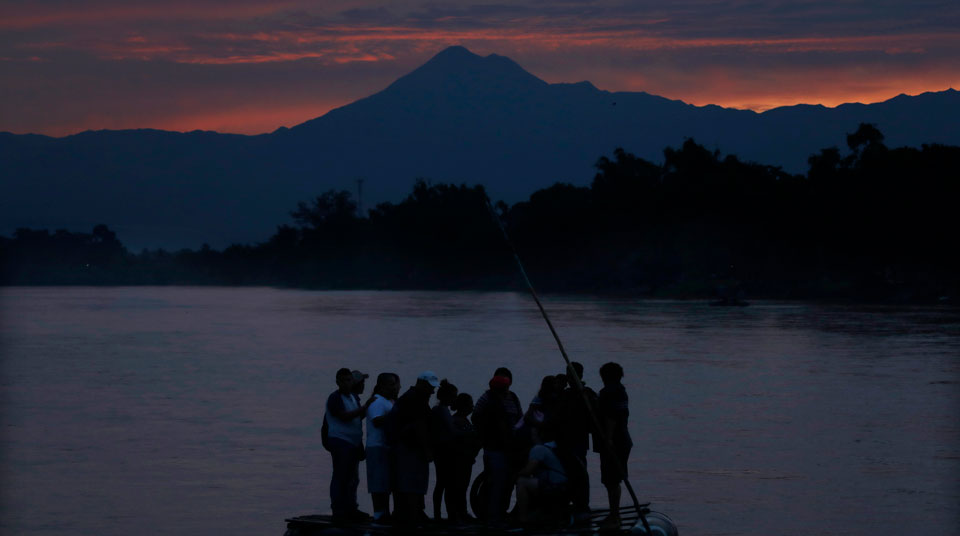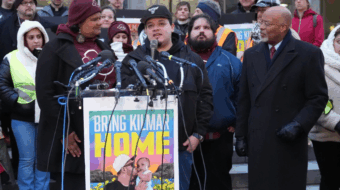
The horrific image of a drowned father and his little daughter in the Rio Grande on the U.S.-Mexico border has intensified efforts in and out of Congress to deal with the situation of refugees and migrants trying to reach the United States from the Northern Triangle of Central America—Guatemala, Honduras, and El Salvador—and points beyond. Unfortunately, most of the solutions proposed by U.S. politicians do not deal with the root causes of this surge in cross-border migration, which is a worldwide phenomenon. And one “solution” being developed by the Trump administration promises to make the situation worse for many migrants and refugees.
On Wednesday, June 26, President Trump announced that the United States and Guatemalan governments are close to agreeing on an arrangement whereby migrants from other countries who otherwise would be trying to reach safety in the United States will have to stay in Guatemala, a “safe third country,” until their asylum requests are processed. At writing, Guatemala has not yet confirmed that any deal has been reached.
But Guatemala may be the worst of the three countries for the protection of human rights.
Guatemala, population 17 million, is on paper the least poor of the three very poor nations of the Northern Triangle. However, it shares with them, and especially with neighboring Honduras, some other characteristics which impel the flight of migrants and refugees from the whole region. One is extreme inequality, which in the case of Guatemala has a deeply rooted racial-ethnic dimension. More than half the population belongs to a variety of indigenous ethnic communities, with at least 45% speaking indigenous languages, mostly of the Mayan family, as their first language. But only Spanish is recognized as an official language.
The indigenous population has, since the Spanish conquest in the 16th century, been marginalized from economic, social, and political power in Guatemala. The question of landholding is just one aspect of this marginalization: Today, for example, 1.9 % of the agricultural producers in Guatemala control 65% of the land, while 92% of agricultural producers, including the vast majority of indigenous farmers, control only 22% percent, according to the Association of Maya Lawyers and Notaries of Guatemala. Attempts of indigenous communities to remedy that situation have often been met with brutal repression, and the hands of the U.S. government and corporations are far from clean.
In the early 20th century, the whole Central America region, including Guatemala, came under the control of predatory U.S.-based corporations which turned the countries into the infamous “banana republics.” In Guatemala, the United Fruit Company gained huge privileges during the presidency of Manuel Estrada Cabrera (1898-1920), which were intensified during the presidency of José María Orellana (1921-26) and the bizarre fascist dictatorship of General Jorge Ubico Castañeda (1931-44). During this time, the real rulers of Guatemala were the United Fruit Company, the local elite landowning group, and the military. Labor unions, the left, and the indigenous population suffered heavy and violent repression.
In 1944, a grassroots rebellion of peasants, workers, and intellectuals pushed aside the Ubico regime and took steps toward the democratization of the country. Two successive presidents, Juan José Arévalo (1945-51) and Jacobo Árbenz Guzmán (1951-54), attempted to use the break from plutocratic dictatorships to promote moderate reforms in the country. Attempts by Árbenz to implement land reform, however, impinged on the wealth and power of United Fruit, which used its clout with the Eisenhower administration to assure that the United States would overthrow the Guatemalan government and replace it with one friendly to U.S. corporate interests.
After the 1954 coup, Guatemala reverted to decades more of brutal military dictatorships backed by the United States. Armed resistance to the military regimes was the pretext for a wave of repression by military forces and paramilitary death squads which resulted in the death of at least 200,000 people and the disappearance of another 50,000, most of them indigenous Mayas.
A new element was also introduced more recently: Right-wing fundamentalist evangelical Christianity, whose leaders have often aligned themselves with the political right as well. The dictator who presided over one of the worst bouts of genocide against the indigenous population, Efrain Rios Montt, who ruled from 1982 to 1983, boasted about his own Evangelical Christian beliefs and had close ties to right-wing Christian groups in the United States.
In 1996, a peace agreement was signed between the Guatemalan government and the left-wing guerrillas. But peace has not brought equality, democracy, or social justice. During the long years of war and genocide, the most corrupt and violent elements of the military and police had developed close ties with criminal enterprises, and that alliance was in turn linked with the interests of the Guatemalan elite and international monopoly capital. The oppression of the indigenous and the poor continued, as did much of the violence.
Not much has been achieved in the electoral field to change this picture. The current president, Jimmy Morales, was elected in 2015 as the candidate of a political party backed by extremist right-wing ex-military officers, the National Convergence Front. He has stated that the killings in the military period were not genocide, and he has been working to stop any efforts to bring justice to the victims of the killers or to fight the corruption which has infected his government and its predecessors.

He is trying to eliminate the CCIG, the UN-sponsored International Commission Against Impunity in Guatemala, which, working with Guatemalan prosecutors, had put his predecessor in the presidency, General Otto Pérez Molina, in jail for corruption, and has been snapping at Morales’ heels as well.
There is talk of amnesty for some of the people convicted of crimes against humanity during the civil war and of eliminating public access to a key archive of documents which record the genocide, the Historical Archive of the National Police.
In the lead-up to the June 16 first-round elections this year, the main anti-corruption presidential candidate, former Attorney General Thelma Aldana, who had a record of successfully prosecuting corruption cases, including that of Perez Molina, was disqualified from running because of what many see as cooked-up corruption accusations.
On August 11, Guatemalans get to choose between two run-off candidates, centrist former first lady Sandra Torres, and right winger Alejandro Giammattei, neither of whom are inspiring much confidence among the working class and poor farmers. Morales’ own far-right party, the National Convergence Front, took a beating in the first-round legislative vote, but other right-wing parties did better, and there were small advances for the left.
On top of all this, Guatemala is undergoing a rural environmental and food crisis, because of a drought caused by global warming which has ruined much of the coffee crop.
So even as Trump spins fantasies about sending Honduran and Salvadoran refugees to Guatemala, as a “safe third country,” which it definitely is not, poor Guatemalans themselves are fleeing to Mexico in the hope of reaching the United States.










